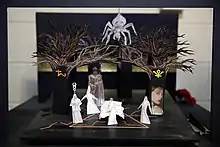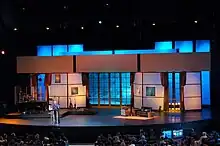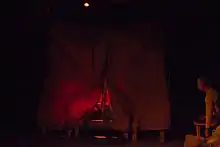Scenic design
Scenic design, also known as stage design or set design is the creation of scenery for theatrical productions like plays and musicals. It may also be applied to film and television contexts, where it is referred to as production design.[1] Scenic designers create sets and scenery to support the overall artistic goals of the production. Scenography includes theatrical set design as well as light and sound.




Scenic designer
A scenic designer works with the theatre director and other designers to establish a visual concept for the production and to design the stage environment. They are responsible for developing a complete set of design drawings that include the following:
- Basic floor plan showing all stationary scenic elements.
- Composite floor plan showing all moving scenic elements, indicating both their onstage and storage positions.
- Complete floor plan of the stage space incorporating all elements.
- Front elevations of every scenic element and additional elevations of sections of units as required.
Additionally, scenic designers often have professional skills like carpentry, architecture, textual analysis, and budgeting. [2]
In planning, scenic designers often make multiple scale models. Models are often made before the final drawings are delivered to the scene shop for construction.[3]
While historically done by hand, many scenic designers use 3D CAD models to produce these design drawings.[4]
Responsibility

The scenic designer collaborates with the director and other creative team members to create an appropriate environment for the production. They are responsible for creating scale models of the scenery, as well as renderings, paint elevations, and scale construction drawings to effectively communicate with other production staff. The primary duties of a scenic designer include communicating the details of the scenic environment to the technical director, production manager, charge scenic artist, and prop master.
Training
In Europe and Australia,[5] many scenic designers take a more holistic approach to theatrical design and are often responsible not only for scenic design, but also costume design, lighting design and sound design. They are called theatre designers, scenographers, or production designers.
Notable set designers
Notable scenic designers, past and present, are: Adolphe Appia, Boris Aronson, Alexandre Benois, Alison Chitty, Antony McDonald, Barry Kay, Caspar Neher, Cyro Del Nero, Aleksandra Ekster, David Gallo, Edward Gordon Craig, Es Devlin, Ezio Frigerio, Christopher Gibbs, Franco Zeffirelli, George Tsypin, Howard Bay, Inigo Jones, Jean-Pierre Ponnelle, Jo Mielziner, John Lee Beatty, Josef Svoboda, Ken Adam, Léon Bakst, Luciano Damiani, Maria Björnson, Ming Cho Lee, Natalia Goncharova, Nathan Altman, Nicholas Georgiadis, Oliver Smith, Ralph Koltai, Emanuele Luzzati, Neil Patel, Robert Wilson, Russell Patterson, Brian Sidney Bembridge, Santo Loquasto, Sean Kenny, Todd Rosenthal, Robin Wagner, Tony Walton, Louis Daguerre, Ralph Funicello, and Roger Kirk.
See also
References
- LuPone, Robert (2008), Erlhoff, Michael; Marshall, Tim (eds.), "Set Design", Design Dictionary, Basel: Birkhäuser Basel, pp. 357–359, doi:10.1007/978-3-7643-8140-0_245, ISBN 978-3-7643-7739-7, retrieved 2023-10-11
- "Set Designer | Berklee". www.berklee.edu. Retrieved 2023-10-21.
- Pincus-Roth, Zachary (2008-01-31). "ASK PLAYBILL.COM: Sets". Playbill. Retrieved 2019-10-31.
- "Scenic Designer | Yale Undergraduate Production". up.yalecollege.yale.edu. Retrieved 2021-12-22.
- "Training as a Theatre Designer". Central School of Speech and Drama, University of London article. Archived from the original on 2016-09-03. Retrieved 2011-04-02.
Further reading
- Brockett, Oscar G., Margaret Mitchell, and Linda Hardberger. Making the Scene: A History of Stage Design and Technology in Europe and the United States, Tobin Theatre Arts Fund, distributed by University of Texas Press, 2010. Traces the history of scene design since the ancient Greeks.
- Pecktal, Lynn. Designing and Painting for the Theater, McGraw-Hill, 1995. Details production design processes for theater, opera, and ballet. The foundational text provides a professional picture and comprehensive references to the design process. Well-illustrated with detailed lined drawings and photographs to convey the beauty and craft of scenic and production design.
External links
 Media related to Scenography at Wikimedia Commons.
Media related to Scenography at Wikimedia Commons.- Prague Quadrennial of Performance Design and Space Largest scenography event in the world.
- What is Scenography Article illustrating the differences between US and European theatre design practices.